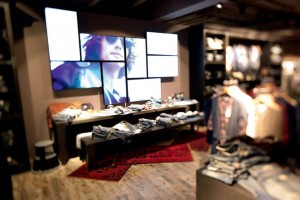Las experiencias sensoriales aumentan un 10% las ventas en tienda, según un estudio de Mood Media
El estudio conductual realizado por Walnut Unlimited para este especialista tecnológico y el minorista deportivo Intersport confirma que el marketing sensorial tiene un impacto emocional, cognitivo y conductual positivo en los compradores.
Mood Media, especialista soluciones de medios en el punto de venta para mejorar la experiencia del cliente, ha presentado el estudio de marketing conductual Cuantificación del impacto del marketing sensorial, que pone de manifiesto que el marketing sensorial tiene un impacto positivo en los compradores dentro del punto de venta.
En este estudio, Mood Media se ha asociado con Intersport, su cliente minorista internacional de deportes, para llevar a cabo un experimento controlado que descubrió que cuando se aplicaba el marketing sensorial las ventas aumentaban en un 10%, así como que los compradores pasaban casi seis minutos más en la tienda.
 “Conscientes de que el 78% de los compradores del estudio afirma que una atmósfera agradable juega un papel clave a la hora de decidir comprar un producto en una tienda física en vez de online, nos asociamos con Walnut Unlimited para desarrollar una investigación cuantitativa de comportamiento y neuromarketing que demuestre cómo los compradores reaccionan de primera mano a experiencias sensoriales específicas”, explica Scott Moore, chief marketing officer de Mood Media.
“Conscientes de que el 78% de los compradores del estudio afirma que una atmósfera agradable juega un papel clave a la hora de decidir comprar un producto en una tienda física en vez de online, nos asociamos con Walnut Unlimited para desarrollar una investigación cuantitativa de comportamiento y neuromarketing que demuestre cómo los compradores reaccionan de primera mano a experiencias sensoriales específicas”, explica Scott Moore, chief marketing officer de Mood Media.
El resultado de esta investigación es claro para el directivo: “un enfoque estratégico de alto nivel para incorporar elementos sensoriales en la tienda crea una respuesta emocional medible con los consumidores que ofrece positivos resultados finales”.
Para la elaboración del estudio, Mood Media creó un entorno que se dividió en dos fases en una tienda en Ámsterdam. En la primera se activaron todos los elementos sensoriales, incluida la música, el olor a hierba recién cortada y el digital signage. La segunda fue una fase ‘sin sentidos’, eliminando todos los elementos sensoriales y visuales del establecimiento.
 Los resultados obtenidos se compararon con tres ‘tiendas de control’ de la firma Intersport que permanecieron sin cambios en su entorno.
Los resultados obtenidos se compararon con tres ‘tiendas de control’ de la firma Intersport que permanecieron sin cambios en su entorno.
Para medir el impacto emocional del marketing sensorial y obtener información sobre las diferentes respuestas conductuales y cognitivas del consumidor, Walnut Unlimited midió las respuestas galvánicas de la piel (GSR) y el seguimiento visual de los ojos (ET).
“A medida que desarrollamos nuestra estrategia omnicanal, nos enfocamos en mejorar nuestras tiendas físicas con experiencias memorables y atractivas que se conectan con nuestra base de clientes -señala Chris Kleine, director de diseño y desarrollo de IIC-Intersport-. La investigación ha resaltado aún más la importancia de las experiencias sensoriales para crear un ambiente positivo en la tienda que atraiga a los compradores una y otra vez”.
Impacto positivo de los estímulos sensoriales en la tienda
Los compradores compraron más artículos (increase of 4%), así como artículos de mayor precio (incremento del valor del 6%) cuando se implementaron elementos de marketing sensorial.
- El uso del aroma es aún más impactante cuando se utiliza para resaltar un departamento o zona específica. La aromatización de la zona de fútbol consiguió incrementar los niveles emocionales de los clientes en un 28%, en comparación con la cifra inicial.
- Desde que se utilizó la fragancia en el área de fútbol hasta la fecha, Intersport ha notado un aumento del 26% en las ventas en esta categoría en la tienda de prueba, respecto al rendimiento de la misma categoría en todas las otras tiendas en todo el país.
- Según las métricas de seguimiento ocular (ET), la conciencia de la existencia de pantallas digitales en la tienda aumentó un 5% cuando las imágenes en movimiento se activaron en la pantalla digital, frente a las imágenes estáticas.
- Según las métricas de la respuesta galvánica de la piel (GSR), la falta de elementos sensoriales en la tienda provocó que un 17% se sintiera más sensible emocionalmente e incómodo en un entorno inusualmente silencioso y libre de estímulos.
- A los consumidores les gusta verse a sí mismos, lo que el estudio describe como “la ciencia del narcisismo””. Las mediciones de la respuesta galvánica de la piel (GSR) y el seguimiento ocular (ET) mostraron un aumento significativo en la actividad del sistema nervioso y su compromiso cuando los consumidores se vieron reflejados en los espejos e interactuaron con productos frente a dichos espejos.
- Los compradores mostraron un aumento emocional del 50% al tocar e interactuar con un producto.
- Para conocer más detalles y comprender cómo los compradores de Intersport reaccionaron a las experiencias sensoriales pulsar este enlace.
Did you like this article?
Subscribe to our NEWSLETTER and you won't miss anything.




